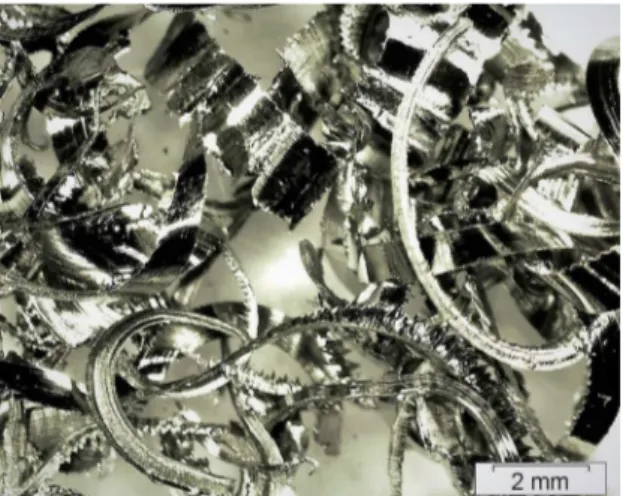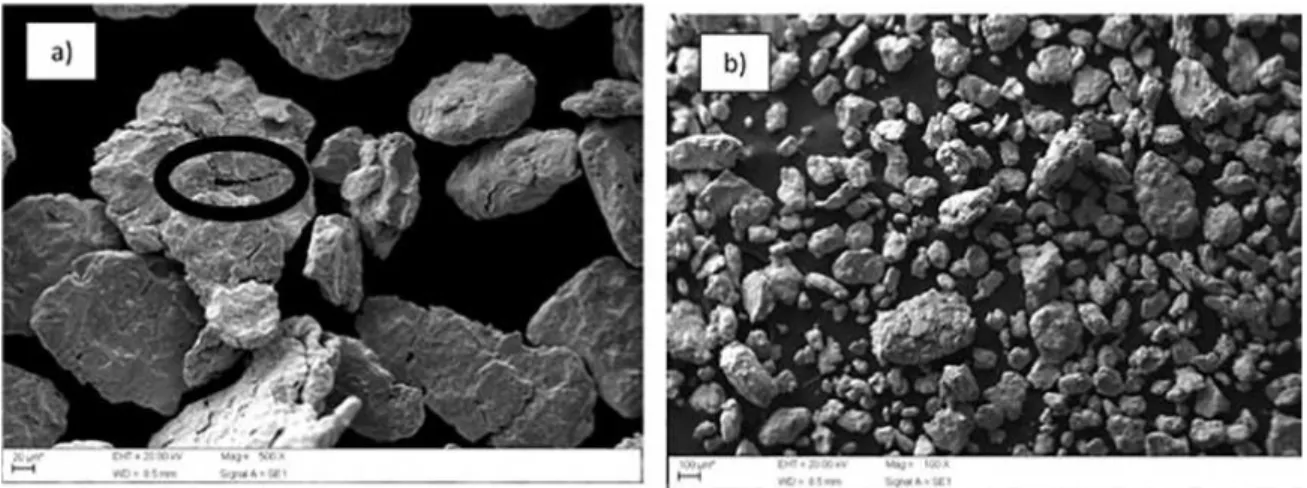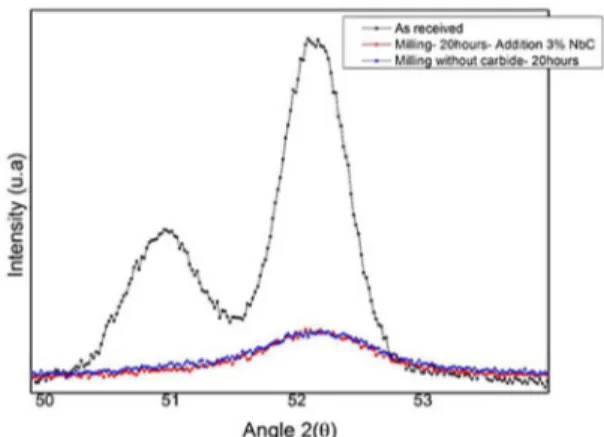Structural and Magnetic Properties of Duplex Stainless steel (UNS S31803) Powders
Obtained by high Energy Milling of Chips with Additions of NbC
Claudiney de Sales Pereira Mendonçaa*, Adhimar Flávio Oliveiraa, Leonardo Albergaria Oliveiraa,
Manoel Ribeiro da Silvaa, Mirian de Lourdes Noronha Motta Meloa, Gilbert Silvaa
Received: August 07, 2017; Revised: September 29, 2017; Accepted: October 05, 2017
In this study, the high energy mechanical milling was utilized to the production of duplex stainless
steel powders from the recycling chips with and without the addition niobium carbide. The effect of
milling time and addition carbide on the morphology, particle size and magnetic properties of the powders was investigated. The utilization of the powder metallurgy constitute an important alternative for the reuse of waste in the industrial sector. The milling was realized using a planetary ball mill for 20 hours at a milling speed of 350 rpm and ball-to-powder weight ratio of 15:1were used, and the (0% and 3 wt. %) niobium carbide (NbC) addition. Scanning electron microscopy and particle distribution analysis were used for characterization of morphology and measure of particle size. Also, to analyze the transformations of phases were investigated using the magnetic characterization and
x-ray diffraction. The results indicated that the addition of niobium carbide results in the reduction of
the particle size of steel of the order of 20%, besides the reduces the transformation of austenite into strain induced martensitic phase.
Keywords: chips, Duplex stainless steel, morphology, magnetic properties, mechanical milling, particle size, niobium carbide, martensite
*e-mail: claudiney.sales@unifei.edu.br
1. Introduction
The utilization of stainless steel has been increased
extensively in various fields in the past few decades1. Duplex
stainless steels (DSS) are characterized by a biphasic structure,
constituting an approximate equal amount of ferrite (α) and austenite (γ). The ferrite phase is responsable for an increased
resistance, while the austenite phase ensures the toughness and better corrosion resistance2-4.
At the end of the useful life of a mechanical component it is discarded in deposits or remelted, making this cycle costly for industry, while the discarding brings environmental problems. The increase in energy costs and raw materials used in the manufacturing processes, which have been
verified in recent years, have led the researchers to develop
new methods of obtaining these materials, an alternative is to reuse machining chips as raw material to manufacture new components mechanics5,6. Recycling is widely used
in metallic materials. A cleaner production of the reuse of materials is the use of powder metallurgy processes that
offer advantages in relation to the conventional process, such
as in the production of small parts of complicated shapes, generally of motors and gears7. This option becomes an
advantageous technique, since 95% of the machined metal chips can be recovered8.
In a recent work, it was verified that the addition of
niobium carbide in the process of high energy milling of
chips of the machining process increases the efficiency of
the milling process, with a greater decrease of the size of the particles, obtaining nanometric particles9,10. The carbides have
attracted interest because of their exceptional mechanical, physical and chemical properties, such as high temperature stability, high hardness, and good electrical and thermal conductivity11,12. The niobium carbide presents a high hardness
and toughness, elevated Young's modulus and a high melting point, above 3000°C12,13. In stainless steel, niobium forms
dispersed micro- or nano-sized niobium carbide particles, controlling the microstructure and thus improving mechanical properties14,15. Furthermore, Brazil has the largest reserves
of niobium in the world, which makes this strategic study for Brazil14.
The process of Mechanical milling (MM) utilizes high frequency and high energy impacts causing severe plastic deformation, repeated fracturing and cold welding of the particles16-18. Due to this, the mechanical milling process
can lead to changes in the microstructures of the austenite and duplex stainless steels with a possible transformation of the martensite phase induced by deformation, from the austenitic phase. Enayati, et.al produced nanocrystalline stainless steel powder by ball milling of austenitic stainless
steel scrap chips and verified that the phase austenite in
as-received chips partially was transformed to the martensite phase after 100 hours milling19.
The aim of this work was to study the influence of
the milling time and carbide addition on the behavior of a
material for the research was obtained through machining in low speed and without lubricants to avoid contamination by oxygen and oil-solubles. From this process, it was possible to obtain the stainless steel alloy in the form of chips for the realization of subsequent milling process. To describe the average proportion of the alloy chip sizes, a stereoscopic macroscopic was used.
The milling was realized using a planetary ball mill for 20 hours in inert argon atmos-phere to avoid oxidation of the powders at a milling speed of 350 rpm and a mass/ sphere relationship of 1:15. 3 wt. % niobium carbide (NbC) with initial size between 5 µm and 15 µm was added to the mill. Every 5 hours a sample of milled powder was taken for characterization, however in this work two milling times were chosen to analyze: 5 and 20 hours.
The characterization of stainless steel duplex milled powder was realized using a scanning electron microscope Carl Zeiss EVO MA15. In the secondary electron (SE) mode, the particle size variation and morphology of powder were analyzed. Using the back scatter electron (BSD) and energy dispersive x-ray (EDS and Mapping) modes the distribution of NbC produced by Hermann C. Starck in matrix was evaluated.
Particle size distribution was performed in a Microtrac Bluewave S3500 to analyze size of powder with increasing
milling time. An X-ray diffraction Panalytical X'pert PRO with CoKα radiation was used for phase identification with
sweeping angle of 45º to 130º, step-size of 0.02º and counting time per step of 2 second.
The characterization of the magnetic properties was performed in a vibrating sample magnetometer Lake Shore model VSM 7404. The amount of ferromagnetic phase was obtained as a function of saturation magnetization, using the formula20.
(1)
Where: Cα is the ferrite amount and Ms is the saturation
magnetization.
It can be seen in Figure 3 (a) that, after 5 hours of milling without the addition of carbides, the UNS S31803 stainless steel in the form of chips was transformed in particles with irregular morphology and dimensions around 600 µm. The encircled region in Figure 3(a) shows the shear area of a particle caused by plastic deformation and consequent displacement of crystal planes during process milling. For
C
M
133
s
=
a
Figure 1. UNS S 31803 Duplex stainless steel in form of chips.
the 20 hours milling, the particles remained in their irregular format, however, a decrease in particle size between 65 µm and 400 µm, as can be seen in Figure 3(b). In the milling process of ductile-ductile system two main processes are distinguished: cold welding (due to ball-powder-ball impacts) and fracturing (due to brittleness induced by work hardening of powders)17,21. The work hardening causes powders to
become brittle, and the fracturing process becomes significant
for longer milling time21.
For the milling with the addition of 3% of NbC after 5 hours, it was possible to obtain particles with sizes between 150 µm and 500 µm and a morphology with irregular particles (Figure 4a). With the increase of the milling time to 20 hours, it was possible to observe that the particles maintained the irregular shape with sizes between 60 µm and 300 µm (Figure 4b). Comparing the milling process of stainless steel in conditions without carbide and with addition of 3% of NbC, under the same milling conditions, a decrease in particle size was observed obtaining particles of size smaller than 300 µm, which demonstrates an increase
in the efficiency of the milling process.
Figure 3. Particles of the duplex stainless steel after (a) 5 hours and (b) 20 hours of the milling.
Figure 4. Particles of the duplex stainless steel duplex with addition of 3% NbC after (a) 5 h and (b) 20 h of milling.
The cumulative particle size analysis curve seen in Figure 5 shows the limits of D10, D50, and D90 used as
the acceptance criteria for the laser diffraction method. For
example, it can be noted in the graph that for 20 hours milling with NbC addition the D50 is 115.8 µm, which means that 50% of particle sizes are below this value (i.e., the median diameter). Similarly, D10 and D90 are 65.3 µm and 355.7 µm, indicating that 10% of particles are below 65.3 µm and 90% of particles are below 365.7 µm respectively.
It can be seen in Table 1 the "D" values referring to D10, D50, and D90 and the size medium particles of the duplex stainless steel powders in function of the milling with and without carbide. From the analysis of the results, it is noted that the particle distribution for the D50 and D90 values is reduced by the addition of 3% NbC. These results show that
the addition of NbC causes an increase in the efficiency of
Figure 5. Volumetric distribution as a function of the particle size of the milling with and without addition of the NbC.
Table 1. Duplex stainless steel powders “D” values.
Duplex stainless steel particles after milling D10 (µm) D50 (µm) D90 (µm) Average size (µm)
Without carbide 65.3 134.8 473.3 219.7
With addition of 3% NbC 65.6 115.8 355.7 175.6
Figure 6. SEM image of the duplex stainless steel particles with NbC after 20 hours milling in the BSD mode (a); EDS analysis of duplex stainless steel for identifcation of main chemical elements (b).
spots represent the niobium because of the higher atomic weight of niobium. Figure 6b shows the chemical elements obtained by dispersive energy spectroscopy (EDS). The corresponding elements of the duplex stainless steel were found as Fe, Cr, Ni, Si, as well as the elements constituting carbide niobium Nb and C.
Figure 7 shows the magnetic behavior of the UNS S31803 duplex stainless steel under the following conditions: (a) as received; (b) after 5 hours of milling; (c) after 5 hours of milling with addition 3% NbC; (d) without addition of 3% NbC after 20 hours of milling; (e) with addition of 3% NbC after 20 hours of milling.
Analyzing the results of Figure 7, it is noted that the samples after milling have increased saturation magnetization (MS) and the greater the time the greater the value obtained. The saturation magnetization depends only on the volume fraction of the magnetic phase, the increase in the value of
phases present in duplex stainless steel. The material as received presents the ferrite and austenite phase. It is noticed that the increase of the milling time promotes the percentage increase of the ferromagnetic phase. The magnetization
saturation increase with cold deformation process confirms the α′ generation by the γ → α′ reaction20.
For the 5 hour milling time, an increase in the saturation magnetization values was observed in relation to the material as received, and consequently the amount of martensitic phase formed. The values obtained for the saturation magnetization in the milling samples with carbon addition are a little bit more than obtained for Ms in the grinding without carbide. Being
that they are samples with different characteristics, the values obtained are different. Therefore, the 5 hour milling time did not substantially influence the saturation magnetization.
Figure 7. Magnetization curve as a function of the magnetic field applied in duplex stain-less steel samples under different conditions:
(a) as received; (b) after 5 hours of milling without carbide; (c) adding 3% NbC after 5 hours of milling (d) addition of 3% NbC after 20 hours of milling; (e) after 20 hours of milling without carbide.
Table 2. Percentage of ferromagnetic phase and phases present in duplex stainless steel under different conditions.
Conditions Saturation magne-tization (emu/g) (%) Ferromagnetic phase (%) Martensite
As received 62.1 46.7 0.0
After 5 hours of milling 75.2 56.5 9.8
After 5 hours of milling + 3% NbC 76.4 57.4 10.7
After 20 hours of milling 100.6 75.6 28.9
After 20 hours of milling + 3% NbC 87.8 66.0 19.4
Figure 8. Diffractogram of stainless steel duplex UNS S31803 under
the conditions: (a) as received; (b) after 20 hours of grinding without carbide; (c) after 20 hours of milling with addition of 3% NbC.
Figure 9. X-ray diffraction Figure 7 details showing only the
ferrite, austenite and marten-site phase peaks for the regions of
2(θ) between 50 and 54°.
this may be due to the particles of the ceramic material collide with the particles of the metallic material, this kind of behavior could cause collisions that will weakness the region on the ductile particles that will lead to rupture the material by shear.
Figure 8 shows the X-ray diffraction results of the
UNS S31803 duplex stainless steel under the conditions as received, after 20 hours of milling without addition of carbide and the powders after 20 hours of milling with addition of 3% of NbC.
Due to the milling process it is observed that peak intensity decreases and even disappears, and its width grows and the material is moving towards its amorphization due to the introduction of mechanical deformation in the crystalline planes
resulting in particle and crystallite refinement. Measurements based upon the breadths and shapes of the X-ray reflections
indicate that lattice distortion is predominantly responsible for the broadening. In some special cases, there is a large displacement of the cold-worked peak due to an overall expansion of the lattice, or to the presence of stealing faults22.
Due to the detection limit of the x-ray apparatus the niobium carbide phase could not be found.
It can be seen in the diffractogram of Figure 9 that after
the milling process, there was a decrease in the intensity and the broadening of the peaks of the ferritic (110) and austenitic (111) phase and the occurrence of the martensitic phase induced by the deformation. The peaks of the ferrite and martensite phases are not distinguished because both
phases present the same reflection.
This broadening of the peaks of the material subjected to milling for 20 hours, as a function of non-uniform plastic deformation (microtension) of the crystalline lattice, from the stacking faults, shear planes, among other crystalline defects resulted from the decrease in particle size23. The
reducing the average particle size by around 20%.
5. Acknowledgments
The authors acknowledge The Brazilian agencies CNPq,
CAPES and FAPEMIG for financial support.
6. References
1. Shashanka R, Chaira D. Optimization of milling parameters for the synthesis of nano-structured duplex and ferritic stainless steel powders by high energy planetary milling. Powder Technology. 2015;278:35-45.
2. Ghosh SK, Mahat D, Roychaudhuri R, Modal R. Effect of
rolling deformation and solution treatment on microstructure and mechanical properties of a cast duplex stainless steel.
Bulletin of Materials Science. 2012;35(5):839-846.
3. Gunn RN. Duplex stainless steels- Microstructures, properties
and applications. Cambridge: Woodlhead Publishing; 2003.
4. Fréchard S, Martin F, Clément C, Cousty J. AFM and EBSD combined studies of plastic deformation in a duplex stainless steel. Materials Science and Engineering: A. 2006;418(1-2):312-319.
5. Dobrzanski LA, Brytan Z, Grande MA, Rosso M, Pallavicini EJ. Properties of vacuum sintered duplex stainless steels. Journal
of Materials Processing Technology. 2005;162-163:286-292.
6. Delforge DYM, Ferreira I, Silva CGR, Paris EAG, Marcelo AL, Novaes RH. Sinterização de uma mistura de cavaco de aço inoxidável com pó do mesmo material. Uma nova tecnologia para a reciclagem de metais? Rem: Revista Escola de Minas. 2007;60(1):95-100.
7. Bautista A, Velasco F, Campos M, Rabanal ME, Torralba JM. Oxidation Behavior at 900°C of Austenitic, Ferritic, and Duplex Stainless Steels Manufactured by Powder Metallurgy.
Oxidation of Metals. 2003;59(3-4):373-393.
11. Gubernat A, Zych L. The isothermal sintering of the single-phase non-stoichiometric niobium carbide (NbC1-x) and tantalum carbide (TaC1-x). Journal of the European Ceramic Society. 2014;34(12):2885-2894.
12. Kosolapova TY. Carbides properties, production and applications. New York: Springer Publishing; 1971.
13. Madej M. Phase reactions during sintering of M3/2 based composites with WC additions. Archives of Metallurgy and Materials. 2013;58(3):703-708.
14. Acchar W, Camara CRF, Cairo CAA, Filgueira M. Mechanical performance of alumina reinforced with NbC, TiC and WC.
Materials Research. 2012;15(6):821-824.
15. Woydt M, Mohrbacher H. Friction and wear of binder-less niobium carbide. Wear. 2013;306(1-2):126-130.
16. Alam SN. Synthesis and characterization of W-Cu nanocomposites developed by mechanical alloying. Materials Science and
Engineering: A. 2006;433(1-2):161-168.
17. Suryanarayana C. Mechanical alloying and milling. Progress
in Materials Science. 2001;46(1-2):1-184.
18. Gleiter H. Nanostructured materials: basic concepts and microstructure. Acta Materialia. 2000;48(1):1-29
19. Enayati MH, Bafandeh MR, Nosohian S. Ball milling of stainless steel scrap chips to produce non-ocrystaline powder. Journal
of Materials Science. 2007;42(8):2844-2848.
20. Tavares SSM, Silva MR, Pardal JM, Abreu HFH, Gomes AM. Microstructural changes produced by plastic deformation in the UNS S31803 duplex stainless steel. Journal of Materials
Processing Technology. 2006;180(1-3):318-322.
21. Canakci A, Varol T. A novel method for the production of metal powders without conventional atomization process. Journal of
Cleaner Production. 2015;99:312-319.
22. Auld JH, Garrod RI. X-Ray Line-Broadening from Cold-worked Iron. Nature. 1952;169:579-580.



